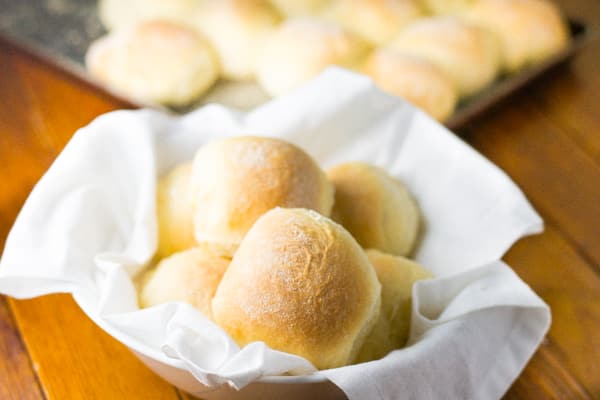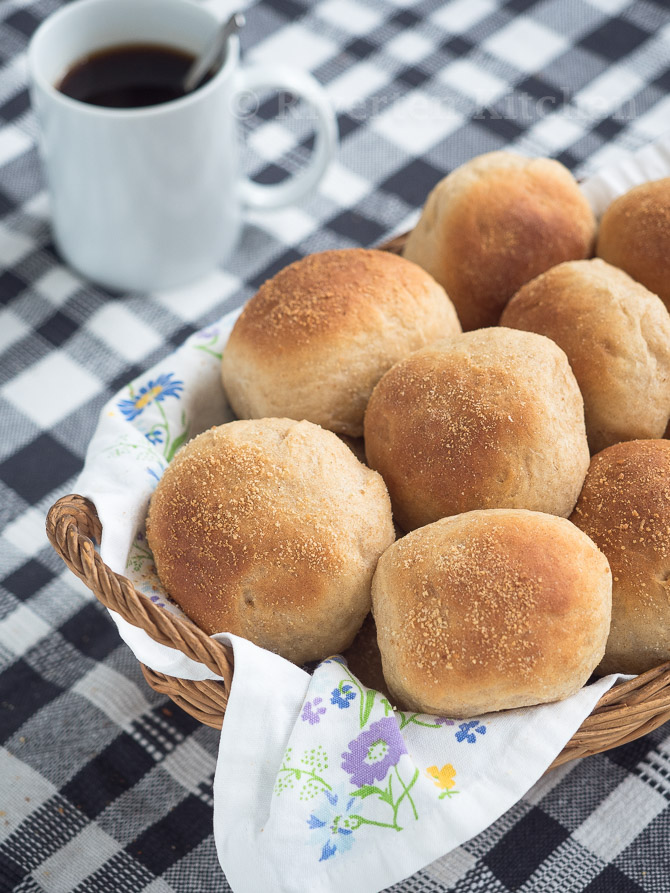25 comments and a History about Philippines' favorite bread
 •
by
•
by Juan Bato
How Pandesal Became a Filipino Breakfast Staple
The soft and airy flour roll is as close as it comes to a national dish.
While the Philippines doesn't officially have a national bread, if it did, it would be pandesal. A soft and airy flour roll, pandesal —€” which is sometimes spelled out as "pan de sal" —€” is Spanish for "salt bread." However, contrary to its name, the bread is actually relatively sweet. The yeast-raised bread is similar to the Mexican bolillo, and is the breakfast bread of choice throughout the Philippines.

Regardless of their socioeconomic status, all Filipinos eat pandesal regularly, says Nicole Ponseca, the restaurateur behind Maharlika and Jeepney, two successful Filipino restaurants in New York City. "It's not a celebratory food, but one that is eaten every day, and it's consumed regularly up and down the country by the rich and by the poor," she says. "Even if you're just scraping by, you can still afford a pandesal."

"It’s consumed regularly by the rich and the poor. Even if you’re just scraping by, you can still afford a pandesal."
Ponseca explains that Filipinos "eat many small meals throughout the day," and having two breakfasts —€” one lighter, one heartier —€” is not uncommon. Pandesal is typically consumed as part of the first, simpler meal Filipinos sit down to before a heartier breakfast known as almusal. During the earlier morning meal, pandesal is frequently consumed plain with a cup of black coffee or hot chocolate for dipping, says Ponseca. According to Filipino chef and food historian Ariel Layug, the bread also lends itself well to a number of spreads, the most popular of which are coconut jam, peanut butter, and butter or margarine (often with a sprinkle of sugar).

While some people do make pandesal at home, it's most frequently purchased from a local bakery, which are very common in cities and towns, explains Layug. Even small villages in the Philippines receive "daily deliveries of pandesal from city bakeries via motorcycle or bicycle," he says. The bread has been a staple of the Filipino daily diet for generations.
Origins
Pandesal is essentially a Philippines history lesson in bread form, though its origin stories are a bit murky. Until the Portuguese arrived in the Philippines, the indigenous diet was primarily focused on rice. "Wheat isn't native to the country," explains Ponseca. The majority of Filipino historians agree that the earliest version of wheat-based bread was introduced by Portuguese explorers and early settlers in the 1500s.
With the Portuguese, and eventually the Spanish colonizers, came strong ties to the Catholic church, which according to Layug, needed wheat to produce "the hostia, or sacramental bread, in their quest to convert indigenous people." Layug notes that not much is known about the first iteration of bread introduced to the Philippines, but it likely used tuba, an alcoholic coconut toddy, as a leavening agent, because yeast was not widely available yet. But this early bread iteration would have been quite different from pandesal.
Modern pandesal and other wheat-based foods flourished in the Philippines when the price of American wheat became cheaper than rice.
According to the Manila-based food site Pepper, wasn't until the Spaniards attempted to "create an answer to the French baguette" that the original pandesal was born. That version was made with whole wheat flour and baked in a pugon, a wood-fired oven that rests on the floor — also known as pan de suelo. Ponseca says the pan de suelo, or "floor bread," is still popular in the Philippines today, but it is much crustier and sturdier than the modern pandesal.
Due to the fact that the Philippines does not grow wheat and imports most of its supplies — something that remains true today — bakers had to turn to a more affordable version of flour, resulting in the soft, doughy bread that is recognized as pandesal today. Modern pandesal and other wheat-based foods really flourished in the 1900s when the price of American wheat became cheaper than rice. The wheat of choice is typically grown in the U.S. Pacific Northwest, has less protein, and can be stored for a year.
Layug says the influx of American immigrants to the country during first half of the 20th century also helped to lower the production costs of pandesal through the "introduction of commercial yeast, canned dairy, and baking pans." Americans also brought with them their health program which "promoted better hygiene" (baking bread in pans, not on the floor), and a "healthier" American diet, which was heavy on the wheat and dairy.
Photo: Paolo/Flickr
How It’s Made
To make a modern pandesal, according to Layug, yeast is first bloomed in either warm water or milk. It is then added to flour mixed with sugar and a pinch of salt, then formed into a dough that is left to rise. The dough is then rolled out to form a log known as a baston. The log of dough is then sliced into individual pieces known as singkit — which translates to "narrow eyes." This is a reflection of how the dough looks, says Layug — oval with a "noticeable cut ridge." Unlike other bread rolls, there is no shaping of the individual pieces when making pandesal (the rolls are not scored on top either, like they would be in a baguette). The cut sides of the singkit pieces are instead dipped into breadcrumbs — a distinct feature of pandesal — and are left to rise for a second time. The rolls are then baked until golden and crusty.
If not consumed at breakfast, pandesal is a popular choice for a mid-morning or mid-afternoon snack time known as merienda. Then, the bread is transformed into a simple sandwich which is often filled with just a piece of a fried Spam, says Ponseca. Other variations include mayonnaise spiked with chicken or tuna salad or a layer of sautéed corned beef. Regardless of what time of day people consume pandesal, the key is to eat it hot out of the oven. Once the bread cools, it changes texture and becomes much more crumbly, warns Ponseca.
The "Eggs Benigno" at Maharlika in NYC. Photo: erin/Flickr
Modern Iterations
One of the most famous spots for pick-up pandesal in the Philippines is Kamuning Bakery in Quezon City. The bakery, which is one of the oldest in the city, has been producing pandesal since it opened its doors in 1939. (It also happens to be one of Ponseca's personal favorites.) In the capital city of Manila, Pan de Manila is one of the most common places to pick up a bag of the bread.
But in recent years, a number of bakeries across the Philippines have gotten creative with pandesal, offering riffs on the popular bread roll. Layug is a huge fan of the variations, especially the ones flavored with ube, the bright purple yam beloved by Filipinos. Companies are now making healthier versions with whole wheat flour, as well as versions flavored with items like carrots, garlic, and even hot dogs.
Pandesal is now also used as a base for more playful dishes, like a take on a peanut butter and jelly, bread pudding, or a Bagel Bites-like pandesal pizza. Ponseca pushes the bread one step further at Maharlika and uses it as the foundation for her very Filipino makeover of the brunch classic eggs benedict. Dubbed "Eggs Benigno," Ponseca swaps pandesal for the English muffins, and tops each piece with crispy Spam (instead of ham), poached eggs, and a drizzle of a kalamansi-spiked hollandaise. She has also transformed day-old pandesal into croutons for a Filipino take on a panzanella, tossing the bread with tomatoes and a fermented shrimp paste.
In the Philippines, it's not uncommon to use pandesal as a vessel for ice cream, either. "You could save a couple of pesos by going to an ice cream man and giving him pandesal instead of a cone," Ponseca says. "He would take it and stuff it with ice cream," an item that she fondly calls a "dirty ice cream" and often serves at her restaurants.
As for where to find great pandesal in the U.S., Ponseca turns to Valerio's City Bakery, a Filipino bakery chainlet with five locations in California. The bakery first opened in 1979 and serves a full range of Filipino baked goods. However, the pandesal, its first menu item, is still legendary. Ponseca confesses: "My mouth waters just thinking about them."


Comments
I misread the title thinking it was going to be about history and started reading and thought - this is all about bread, then re-read the title.
Hahaha! This made my day. Thank you for reading 🙂
comment